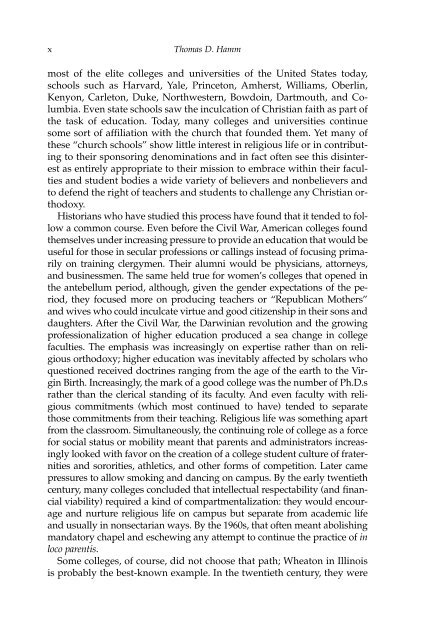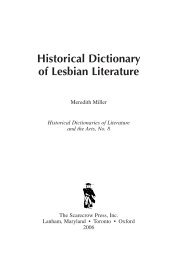Founded by Friends : the Quaker heritage of fifteen - Scarecrow Press
Founded by Friends : the Quaker heritage of fifteen - Scarecrow Press
Founded by Friends : the Quaker heritage of fifteen - Scarecrow Press
Create successful ePaper yourself
Turn your PDF publications into a flip-book with our unique Google optimized e-Paper software.
x Thomas D. Hamm<br />
most <strong>of</strong> <strong>the</strong> elite colleges and universities <strong>of</strong> <strong>the</strong> United States today,<br />
schools such as Harvard, Yale, Princeton, Amherst, Williams, Oberlin,<br />
Kenyon, Carleton, Duke, Northwestern, Bowdoin, Dartmouth, and Columbia.<br />
Even state schools saw <strong>the</strong> inculcation <strong>of</strong> Christian faith as part <strong>of</strong><br />
<strong>the</strong> task <strong>of</strong> education. Today, many colleges and universities continue<br />
some sort <strong>of</strong> affiliation with <strong>the</strong> church that founded <strong>the</strong>m. Yet many <strong>of</strong><br />
<strong>the</strong>se “church schools” show little interest in religious life or in contributing<br />
to <strong>the</strong>ir sponsoring denominations and in fact <strong>of</strong>ten see this disinterest<br />
as entirely appropriate to <strong>the</strong>ir mission to embrace within <strong>the</strong>ir faculties<br />
and student bodies a wide variety <strong>of</strong> believers and nonbelievers and<br />
to defend <strong>the</strong> right <strong>of</strong> teachers and students to challenge any Christian orthodoxy.<br />
Historians who have studied this process have found that it tended to follow<br />
a common course. Even before <strong>the</strong> Civil War, American colleges found<br />
<strong>the</strong>mselves under increasing pressure to provide an education that would be<br />
useful for those in secular pr<strong>of</strong>essions or callings instead <strong>of</strong> focusing primarily<br />
on training clergymen. Their alumni would be physicians, attorneys,<br />
and businessmen. The same held true for women’s colleges that opened in<br />
<strong>the</strong> antebellum period, although, given <strong>the</strong> gender expectations <strong>of</strong> <strong>the</strong> period,<br />
<strong>the</strong>y focused more on producing teachers or “Republican Mo<strong>the</strong>rs”<br />
and wives who could inculcate virtue and good citizenship in <strong>the</strong>ir sons and<br />
daughters. After <strong>the</strong> Civil War, <strong>the</strong> Darwinian revolution and <strong>the</strong> growing<br />
pr<strong>of</strong>essionalization <strong>of</strong> higher education produced a sea change in college<br />
faculties. The emphasis was increasingly on expertise ra<strong>the</strong>r than on religious<br />
orthodoxy; higher education was inevitably affected <strong>by</strong> scholars who<br />
questioned received doctrines ranging from <strong>the</strong> age <strong>of</strong> <strong>the</strong> earth to <strong>the</strong> Virgin<br />
Birth. Increasingly, <strong>the</strong> mark <strong>of</strong> a good college was <strong>the</strong> number <strong>of</strong> Ph.D.s<br />
ra<strong>the</strong>r than <strong>the</strong> clerical standing <strong>of</strong> its faculty. And even faculty with religious<br />
commitments (which most continued to have) tended to separate<br />
those commitments from <strong>the</strong>ir teaching. Religious life was something apart<br />
from <strong>the</strong> classroom. Simultaneously, <strong>the</strong> continuing role <strong>of</strong> college as a force<br />
for social status or mobility meant that parents and administrators increasingly<br />
looked with favor on <strong>the</strong> creation <strong>of</strong> a college student culture <strong>of</strong> fraternities<br />
and sororities, athletics, and o<strong>the</strong>r forms <strong>of</strong> competition. Later came<br />
pressures to allow smoking and dancing on campus. By <strong>the</strong> early twentieth<br />
century, many colleges concluded that intellectual respectability (and financial<br />
viability) required a kind <strong>of</strong> compartmentalization: <strong>the</strong>y would encourage<br />
and nurture religious life on campus but separate from academic life<br />
and usually in nonsectarian ways. By <strong>the</strong> 1960s, that <strong>of</strong>ten meant abolishing<br />
mandatory chapel and eschewing any attempt to continue <strong>the</strong> practice <strong>of</strong> in<br />
loco parentis.<br />
Some colleges, <strong>of</strong> course, did not choose that path; Wheaton in Illinois<br />
is probably <strong>the</strong> best-known example. In <strong>the</strong> twentieth century, <strong>the</strong>y were
















